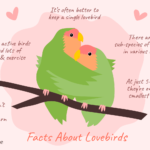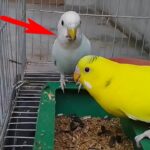Lovebirds and cockatiels differ in size, social needs, and noisiness. Lovebirds are smaller, more sociable, and louder compared to the gentler cockatiels.
Choosing between a lovebird and a cockatiel as a pet requires understanding their specific temperaments and care requirements. Lovebirds are known for their vibrant colors and strong pair bonds, often thriving in pairs. Cockatiels, with their distinctive crests and cheek patches, tend to be more independent but still enjoy human interaction.
They are both popular for their playful nature and ability to form strong attachments with their owners. Deciding on which bird suits you best means considering your lifestyle, the time you can commit to social interaction, and the level of noise you can accommodate. Both birds can make delightful companions, offering unique qualities that appeal to different bird enthusiasts and pet owners alike.
Introduction To Lovebirds And Cockatiels
Lovebirds and Cockatiels light up homes with their vibrant personalities and striking features. These small to medium-sized parrots make fantastic companions, offering pet lovers an opportunity to bring a slice of the exotic bird world into their lives. Deciding between these feathered friends means understanding what sets them apart. Let’s dive into the captivating world of Lovebirds and Cockatiels to help you choose your perfect pet.
Distinctive Traits Of Lovebirds
- Bonding: Known for forming deep bonds, they often prefer the company of their kind.
- Size: Compact and stocky, they measure about 6 inches in length.
- Colors: Display a rainbow of color options, from greens to vibrant blues and yellows.
- Life Span: Can live up to 15 years with proper care.
- Energy Levels: Active and playful, Lovebirds need plenty of stimulation.
Characteristics Of Cockatiels
| Trait | Description |
|---|---|
| Social Nature | Enjoy human interaction and are known for their friendly temperament. |
| Size | Generally larger than Lovebirds, they average about 12 to 14 inches in length. |
| Colors | Typically grey with touches of white and yellow, and a distinctive crest. |
| Life Span | With care, they can bring joy for around 20 years. |
| Vocal Skills | Known for mimicking whistles and can learn to repeat phrases. |

Credit: www.somerzby.com.au
Origins And Natural Habitats
The enchanting world of pet birds boasts a vibrant diversity, Lovebirds and Cockatiels being two star favorites. Each bird species not only has a distinctive personality but also an intriguing origin story and natural habitat. Understanding where these birds come from can shed light on their care needs and behaviors. Let’s take a flight into the ancestral homes of these feathered friends.
African Roots Of Lovebirds
Lovebirds take their name from their strong monogamous pair bonding and the long periods which paired birds spend sitting together. These pocket-sized parrots are native to the sub-Saharan regions of Africa. In the wild, they live in small flocks and favor a variety of environments from woodlands to grasslands.
- Known for their vivid colors and playful nature.
- Natural habitats include Madagascar and mainland Africa.
- Adaptable birds, found both in arid and moist regions.
Australian Lineage Of Cockatiels
The Cockatiel, with its distinctive crest, is the smallest of the cockatoo family and is indigenous to Australia. These birds populate largely in the Australian outback, where they roam the open country, adapting to both bushland and arid regions.
| Cockatiel Features | Details |
|---|---|
| Origin | Australia |
| Habitats | Outback regions, bushlands, and arid areas |
| Diet in the wild | Seeds, fruits, and small insects |
Physical Appearance
Choosing between a lovebird and a cockatiel can be a delightful dilemma for bird enthusiasts. Each species boasts its unique charm; however, their physical appearance sets them apart distinctly. Colorful plumage, size, and distinct features like the cockatiel’s crest make these birds captivating in their ways. Let’s dive into the visual differences that help pet owners decide between a fluffy lovebird or a crested cockatiel.
Plumage And Size In Lovebirds
Lovebirds are famous for their vibrant feathers and compact size. Their bodies are chunky and short, typically measuring 13 to 17 cm (5 to 7 inches) in length.
- Weight: Usually around 40 to 60 grams.
- Wingspan: Between 24 to 28 cm (9.4 to 11 inches).
Their plumage comes in various shades like green, peach, blue, and yellow. Often, lovebirds display a mix of colors that add to their appeal.
| Species | Common Colors |
|---|---|
| Peach-faced Lovebird | Green body, peach face |
| Fischer’s Lovebird | Green body, orange face |
| Masked Lovebird | Dark green body, black face |
Crest And Color Variations In Cockatiels
Cockatiels stand out with their unique crests that they can raise or flatten. Their body size is larger, averaging 30 to 33 cm (12 to 13 inches) from beak to tail.
- Weight: Ranging from 70 to 120 grams.
- Wingspan: Close to 32 to 37 cm (12.5 to 14.5 inches).
They come in a variety of colors too, including:
- Gray (most common)
- White
- Pied
- Yellow
- Cinnamon
Their face colors often complement their body feathers, with males showcasing brighter cheek patches than females. Cockatiels’ feathers can also change shades depending on their mood, age, and health.

Credit: www.amazon.com
Behavioral Tendencies
Choosing between a lovebird and a cockatiel is not easy. Their behaviors can tell you which bird matches your home best. Let’s dive into the world of these chirpy friends and explore their behavioral tendencies.
Social Dynamics Of Lovebirds
Lovebirds are known for their affectionate nature. They often form strong bonds with their partners. In pairs, they show loving behavior, like feeding each other.
- They thrive on attention and love interaction.
- Without socialization, lovebirds may become sad or even depressed.
- Single lovebirds need lots of attention from their human families.
- They can show jealousy if they feel neglected.
It’s crucial to give lovebirds a friend or quality time to keep them happy.
Temperament And Activity In Cockatiels
Cockatiels are known for their gentle and friendly temperament. They are easygoing pets who love to whistle and sing.
| Quality | Description |
|---|---|
| Calm | They remain composed, rarely showing aggression. |
| Curious | They love to explore their surroundings. |
| Playful | Enjoy playing with toys or mimicking sounds. |
| Social | Enjoy human interaction and being part of daily activities. |
Owners should provide various toys and spend time interacting to keep their cockatiels entertained.
Lifespan And Health Considerations
Are you choosing between a lovebird and a cockatiel? One important factor to consider is longevity and health. These playful feathered friends come with unique care needs. Let’s explore how long they can spread joy in your home and the health issues you may encounter.
Average Lifespan Of Lovebirds
Lovebirds are known for their vibrant personalities and can live a long life with proper care. Typically, these charming birds enjoy a lifespan ranging from 10 to 15 years. Some lovebirds have been known to live up to 20 years under exceptional circumstances. Factors such as diet, exercise, and emotional well-being significantly impact their longevity.
- Diet: Well-balanced meals contribute to a longer life.
- Exercise: Regular activity ensures good health.
- Emotional well-being: Lovebirds thrive with companionship.
Common Health Issues In Cockatiels
Cockatiels are equally delightful and can often become a long-term friend with an average lifespan of 15 to 20 years. To ensure your cockatiel stays healthy, watch for these common health issues:
| Health Issue | Description | Preventive Measures |
|---|---|---|
| Respiratory Infections | Caused by bacteria or viruses, they can affect breathing. | Maintain clean living conditions and a stress-free environment. |
| Feather Plucking | Stress or boredom can lead to this behavioral problem. | Provide toys and engage in daily interactivity. |
| Obesity | Due to overfeeding and lack of exercise. | Monitor diet and encourage regular playtime. |
Regular check-ups with an avian vet are essential to catch issues early. Keep your cockatiel’s cage clean and provide a nutritious diet for a happier, healthier bird.

Credit: www.amazon.com
Care Requirements
Ensuring that your feathered friend thrives starts with understanding their unique care requirements. Lovebirds and Cockatiels have different needs when it comes to diet, habitat, and mental stimulation. Let’s dive into what each of these charming bird species requires for a happy, healthy life.
Dietary Needs For Lovebirds
Lovebirds pack a punch in personality and similarly, their dietary needs are vibrant and varied. Here’s what they require:
- A balanced diet composed mainly of high-quality pellet food
- Fresh fruits and vegetables daily to ensure they get all their vitamins
- A small amount of seeds and nuts as treats
- Constant access to fresh, clean water
| Food Type | Amount |
|---|---|
| Pellets | 75% |
| Fruits & Vegetables | 20% |
| Seeds & Nuts | 5% |
Cage Size And Enrichment For Cockatiels
Cockatiels crave space and activities. Keep these points in mind for their habitat:
- A spacious cage at least 20″x20″x24″
- Include perches of various sizes for foot health
- Toys and puzzles to promote mental stimulation
- Install a cuttlebone for calcium and beak maintenance
Remember: Cockatiels are social creatures. They thrive with interaction and a rich, engaging environment.
Bonding And Social Interaction
Bonding and Social Interaction are key to having a happy pet bird. Both Lovebirds and Cockatiels can create deep connections with their owners. These birds differ in how they show their love. Learn about these differences below.
Human Attachment In Lovebirds
Lovebirds are known for their strong pair bonds. They often form close ties with people. When you own a Lovebird, it may:
- Follow you around the house.
- Sit on your shoulder.
- Mimic your behavior.
Consistent interaction is key. Spend time with your Lovebird every day. This helps to strengthen your bond.
Cockatiels As Companion Birds
Cockatiels also make excellent companions. They are gentle and affectionate. With a Cockatiel, expect it to:
- Whistle tunes back to you.
- Ask for head scratches.
- Display affection openly.
Training and playing bring you closer. These activities show trust and comfort. Cockatiels enjoy being part of family activities.
Training And Intellectual Stimulation
Lovebirds and Cockatiels shine bright when their minds stay active. A blend of training and fun keeps them sharp and happy. Teaching tricks turns sessions into a game. Mental activities strengthen their smarts. Let’s dive into the engaging world of bird training.
Teaching Tricks To Lovebirds
Lovebirds express joy through play and learn quickly with the right motivation. Start with basic tricks. A popular starting point is the ‘step-up’ command. Here’s a simple guide:
- Stay patient and use a calm voice.
- Offer a treat as a reward.
- Repeat sessions daily for consistency.
As they master the basics, progress to more complex tricks.
- Try the ‘turn around’ trick.
- Guide them gently with a favorite snack.
- Celebrate each small victory with enthusiasm.
Organize short and fun sessions to avoid stress. Keep it under 15 minutes. Use a variety of treats to keep things interesting.
Mental Engagement Activities For Cockatiels
Cockatiels treasure playtime just as much as lovebirds. Their smart brains need puzzles and challenges.
Start with simple toys that require interaction. Foraging toys keep their interest. They mimic the search for food in the wild. Incorporate different textures and colors. A mixed approach enriches their experience.
| Activity | Benefit |
|---|---|
| Mirror Games | Stimulates curiosity |
| Music Sessions | Encourages vocalization |
| Obstacle Courses | Enhances agility |
Engage them with new sounds and teaching simple songs. This can lead to a wonderful bonding experience. Always supervise play sessions to ensure safety.
Noise And Vocalization
When choosing between lovebirds and cockatiels, sound matters. These birds have unique ways of expressing themselves. Let’s dive into the world of chirps and melodies. It’s time to discover which feathered friend best suits your ears.
Lovebirds’ Chirps And Calls
Lovebirds are known for their chatty nature. They enjoy expressing themselves throughout the day. Although smaller in size, their voices pack a punch. Interested in minor chatter? Lovebirds could be right for you.
- Volume: Moderate but can be loud when seeking attention.
- Frequency: Frequent throughout the day.
- Types of sounds: Includes chirps, tweets, and occasional squawks.
Their vivid vocalizations reflect their social nature. Typically, lovebirds’ calls remain at a manageable level. Yet, they may increase in volume when they feel lonely or excited.
Cockatiel Vocal Range And Whistling
Cockatiels stand out with their impressive vocal talents. They whistle tunes, mimic sounds, and even learn phrases. These birds adore a good serenade and often start the day with a song.
- Volume: Varies, often softer than lovebirds.
- Whistling: Known for clear, melodious whistles.
- Mimicry: Can imitate household noises and even phones.
With training, cockatiels may pick up a variety of sounds. Their whistling can be a delightful symphony. If you appreciate a melodic companion, a cockatiel could be the one.
Breeding And Reproduction
Breeding and Reproduction are fascinating aspects of keeping birds as pets. Lovebirds and Cockatiels provide unique insights into avian mating behaviors. This section delves into the enchanting world of how these feathered friends propagate their species.
Breeding Behavior Of Lovebirds
Lovebirds are aptly named for their monogamous partnerships. These colorful creatures develop strong bonds with their mates. During breeding season, their behavior becomes more pronounced. Mates engage in feeding each other and performing mutual preening as a form of affection and bonding which is crucial for successful reproduction.
- Monogamous pair bonds
- Shared nesting responsibilities
- Distinct courtship rituals like head bobbing and tail fanning
Nesting Habits Of Cockatiels
Cockatiels, with their charming crests, approach nesting with a practical bent. Females select the nesting site, typically in a hollow or sheltered spot that offers security.
- Favor sheltered, protected areas for nests
- Utilize a variety of materials to build nests
- Exhibit strong parental instincts
Their reproductive cycle may start with displaying behavior such as wing flapping and vocalizing to attract a mate. Once bonded, a pair works together to prepare their nest.
Pros And Cons Of Each Bird
The decision to bring a feathered friend into your life involves careful consideration of both the positives (pros) and potential challenges (cons) associated with the species of bird. Lovebirds and Cockatiels both offer unique experiences for bird enthusiasts. Understanding the pros and cons of each bird helps in making an informed decision that aligns with your lifestyle.
Benefits Of Owning Lovebirds
- Vivid Plumage: Lovebirds boast a bright array of colors, making them visually stunning as pets.
- Social Creatures: They form deep bonds, often resulting in affectionate interactions with their owners.
- Compact Size: Their small size means they require less space, perfect for smaller living areas.
- Intelligence: Lovebirds are smart and can learn tricks, providing entertainment and bonding opportunities.
Challenges With Cockatiels
- Attention Requirements: Cockatiels need regular engagement to prevent boredom and develop trust.
- Noise Levels: They can be quite vocal, which might not be suitable for noise-sensitive environments.
- Sensitive Respiratory Systems: These birds require a dust-free environment due to their delicate respiratory systems.
- Feather Dust: Cockatiels produce a fine powder to keep their feathers soft, which can be messy.
Making The Choice
Deciding between a lovebird and a cockatiel takes thought and care. Each bird boasts unique qualities and charms. It’s about matching a feathered friend to your lifestyle and preferences. Exploring the specific needs and traits of these birds will guide you to a rewarding decision.
Considerations For Potential Owners
Choosing your new pet means looking at your daily routine. Birds demand time, interaction, and love. Start by assessing your space at home. Lovebirds thrive in pairs, needing more room to bond and play. Cockatiels, often content alone, still require space for their well-being.
Think about the time you can commit. Lovebirds crave attention and flourish with a feathered partner. Single cockatiels look to you for their social fix. Research their lifespan. Lovebirds live around 10 to 15 years, while cockatiels can enjoy 15 to 20 years with proper care.
Noise levels are also a key factor. Do soft chirps or lively chatter suit you? Cockatiels are known for their whistling and vocal skills. Lovebirds can be quite vocal but their calls are generally softer. Here’s a quick glance:
| Factor | Lovebird | Cockatiel |
|---|---|---|
| Space Needs | More (Prefer Pairs) | Less (Can live alone) |
| Life Span | 10-15 years | 15-20 years |
| Noise Level | Soft/Moderate | Whistles/Vocal |
| Interaction | High with partner | High with humans |
Final Thoughts On Selecting Your Pet
After weighing the facts, trust your instinct. Your daily life, space, and the time you can share with your pet will shape your choice. Remember, both lovebirds and cockatiels bring joy and companionship. Either choice adds a vibrant, feathered friend to your family.
- Lovebirds favor those who can accommodate a duo.
- Cockatiels fit well with those seeking a single pet pal.
- Long-term commitment comes with either choice.
- Consider a lovebird or cockatiel to brighten your home and heart.
Conclusion
Both lovebirds and cockatiels offer delightful companionship with their own unique charms. Deciding which feathered friend suits you best hinges on personal lifestyle and preferences. Remember, a happy bird means a happy home. Embrace the journey of pet parenthood as you make your choice.
Ryan Everhart is a passionate bird enthusiast and blogger, primarily writing on his website, Avian Whispers. His journey into the world of bird blogging began with a deep interest in parrots, a species that captivated his attention for their intelligence and social behavior. Over time, his content expanded to cover a broader range of bird species, offering insights into bird behavior, care, habitats, and conservation.
Ryan is dedicated to educating his audience, which includes both new bird owners and seasoned enthusiasts. His writing is filled with personal experiences, expert knowledge, and practical advice on bird care. Through Avian Whispers, he aims to foster a deeper appreciation for birds, emphasizing their role in nature and the joys of having them as pets.
Starting with articles focused on parrots, Ryan’s work now encompasses a diverse range of topics such as feeding, training, habitat enrichment, and bird health. His love for birds extends beyond parrots, diving into various avian species. His informative and heartfelt writing reflects his commitment to the well-being of birds and the desire to help others connect with these creatures.
As a growing voice in the bird blogging community, Ryan strives to provide a platform where bird lovers can learn, share experiences, and connect over a shared passion for avian life. His blogs are not only educational but also serve as a reminder of the importance of protecting and nurturing the bond between humans and birds.




